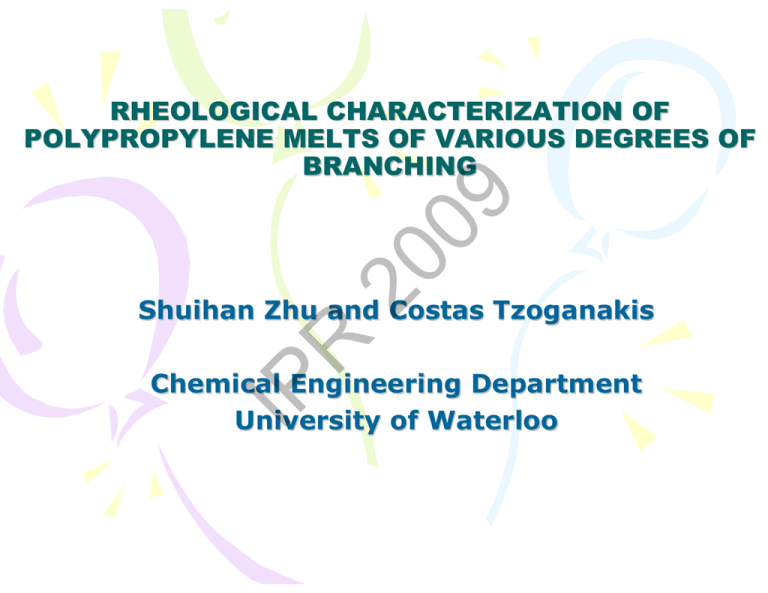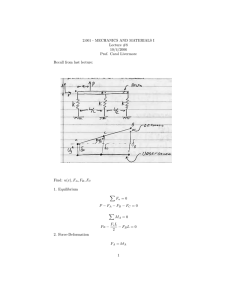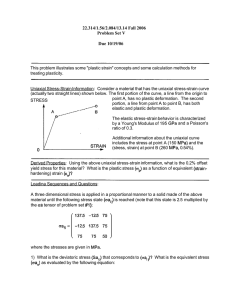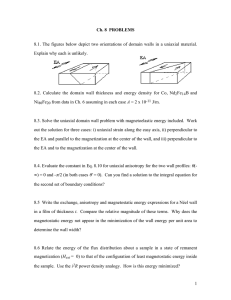RHEOLOGICAL CHARACTERIZATION OF POLYPROPYLENE
advertisement

20
09
RHEOLOGICAL CHARACTERIZATION OF
POLYPROPYLENE MELTS OF VARIOUS DEGREES OF
BRANCHING
R
Shuihan Zhu and Costas Tzoganakis
IP
Chemical Engineering Department
University of Waterloo
Outline
• Introduction
20
09
Rheological properties – molecular structure
Polymer processing
R
• Objectives
• Experiments and Results
IP
Materials
Linear Properties
Nonlinear Properties
• Conclusions
Introduction
• Polyolefin processing
20
09
Film-blowing/fiber spinning
Thermoforming
Foaming
• Molecular structure
IP
R
Molecular weight (chain length)
MWD
Long chain branching (LCB)
• Rheological Characterization
Linear properties: G’, G’’, H(τ),
Nonlinear: elongational viscosity
Introduction
GPC, NMR, etc.
09
Linear properties
20
Molecular structure: LCB
Processing
IP
R
Rheologically
Melt strength
Strain hardening
Model validation
Introduction
• Melt strength
20
09
Constant speed
Draw ratio
One-point extensional viscosity
R
• Strain hardening
IP
Exponential stretching
Planar elongations
Uniaxial elongations
Equibiaxial elongations
Objectives
IP
R
20
09
• Measure and calculate the linear rheological
properties
• Acquire uniaxial and equibiaxial elongational
viscosity
• Compare the results from linear vs nonlinear
rheological properties
• Evaluate difference in uniaxial vs equibiaxial
elongational flows
• Assess the different structures of PP melts
IP
R
20
09
The molecular weights of
the three polypropylenes used.
Mn
Mw
Mz
d
PP-K
47100
326000
971100
6.92
PP-S
69800
342200
991500
4.90
PP-P
79300
384900
1135000
4.85
materials
Shear viscosity at a low shear rate in a c/p rheometer
10
6
5
10
4
10
3
20
09
10
IP
R
0
η (t), Pa s
PP-K
PP-S
PP-P
t
η ( t ) = ∫ G( t' )dt'
o
0
2
10 -2
10
175 0C
Cone angle: 10
Shear rate: 0.001 s-1
RMS800, Rheometrics
10
-1
10
0
10
1
10
t, s
2
10
3
10
4
10
5
Relaxation modulus as a function of time calculated.
5
3
10
2
10
1
10
0
09
10
20
4
R
10
PP-K
PP-S
PP-P
IP
G(t), Pa
10
∞
G( t ) = Ge + ∫ H ( τ ) exp( −t / τ )dτ
−∞
10
-1
10
-2
10
-1
10
0
10
1
10
t, s
2
10
3
10
4
10
5
4
10
3
10
2
10
1
10
0
10
-1
10
-2
10
-3
10
09
10
20
5
R
10
IP
H(τ)
Relaxation spectra of 3 PPs calculated from G(t) vs t.
-4
10
-3
10
-2
PP-K
PP-S
PP-P
10
-1
10
τ, s
0
10
1
10
2
10
3
{
4
10
3
10
2
10
1
10
0
10
-1
10
-2
10
-3
10
-4
10
-5
10
-6
10
-7
10
-8
10
09
10
20
5
∞
G' ( ω ) = Ge + ∫ H ( τ )
−∞
G' ' ( ω ) =
R
10
-4
10
-3
}
ηo ( t) = G' (ω) + 0.27G'' (2ω) + 0.115G'' (4ω) ω=1 / t
∫
∞
−∞
H( τ )
ω2 τ 2
1+ ω τ
2
2
d ln τ
ωτ
d ln τ
1 + ω2 τ 2
G'
G''
IP
G', G''/ Pa
Other linear rheological properties: G’ and G’’
PP-K
PP-S
PP-P
10
-2
10
-1
ω / Hz
10
0
10
1
10
2
4
10
3
10
2
10
1
10
0
10
-1
10
-2
10
-3
10
-4
10
-5
10
-6
10
-7
10
-8
10
PP-K
PP-S
PP-P
09
10
20
5
R
10
IP
G', Pa
Cole-Cole plot of the PP
-4
10
-3
10
-2
10
-1
10
0
G'', Pa
10
1
10
2
10
3
10
4
2
2
t’
t
(0, γ, 0) 3
3
(0, 1, 0)
(1, 0, 1)
⎛ 1 0 0⎞
⎟
⎜
−1
F = ⎜ γ 1 0⎟
⎜ 0 0 1⎟
⎠
⎝
(1, 0, 1)
1
09
Simple shear
(1, 0, 0)
20
(1, 0, 0)
1
(0, 1, 0)
t’
IP
2
⎛ λ1 0
⎜
−1
F = ⎜ 0 λ2
⎜0 0
⎝
R
Elongations
3
(1, 0, 1)
(1, 0, 0)
0⎞
⎟
0⎟
λ 3 ⎟⎠
2
(0, λ2, 0)
t
3
(λ1, 0, λ3)
1
(λ1, 0, 0)
1
3
Deformation gradient
1
Rate of deformation
Simple shear
1
∂F
D = (∇V + ( ∇V ) ) =
⎛0 0 0⎞
2
∂t
⎜
⎟
∇V = ⎜ γ& 0 0 ⎟
⎜0 0 0⎟
⎝
⎠
Uniaxial elongation
0
0 ⎞
⎛ ε&
⎜
⎟
1 &
∇V = ⎜ 0 − 2 ε
0 ⎟
⎜0
1 &⎟
−
ε⎠
0
2
⎝
−1
Planar elongation
⎛ ε& 0 0 ⎞
⎜
⎟
∇V = ⎜ 0 0 0 ⎟
⎜ 0 0 − ε& ⎟
⎝
⎠
Elongation ratio
R
IP
Equibiaxial elongation
0
0⎞
⎛ ε&
⎜
⎟
∇V = ⎜ 0 − 2ε& 0 ⎟
⎜0
0
ε& ⎟⎠
⎝
= F −1∇V
⎛ 1 0 0⎞
⎟
⎜
−1
F = ⎜ γ 1 0⎟
⎜ 0 0 1⎟
⎠
⎝
Finger tensor
C-1=(F-1)TF-1
⎛1 + γ 2 γ 0 ⎞
⎜
⎟
−1
1 0⎟
C =⎜ γ
⎜ 0
⎟
0
1
⎝
⎠
0
0 ⎞
⎛λ
⎟
⎜
−1
1
F = ⎜0 − 2 λ
0 ⎟
⎜0
0
− 21 λ ⎟⎠
⎝
⎛ λ2
⎜
−1
C =⎜0
⎜0
⎝
0
λ−1
0
0⎞
⎛λ
⎟
⎜
−1
F = ⎜ 0 − 2λ 0 ⎟
⎜0
0
λ ⎟⎠
⎝
⎛ λ2
⎜
−1
C =⎜0
⎜0
⎝
0
λ− 4
⎛λ 0 0⎞
⎟
⎜
−1
F = ⎜0 − λ 0⎟
⎜0 0 0⎟
⎠
⎝
⎛ λ2
⎜
−1
C =⎜0
⎜0
⎝
0 0 ⎞
⎟
1 0 ⎟
0 λ−2 ⎟⎠
20
T
09
2
Velocity gradient
λ = exp( ε& t ) = exp( ε )
Hencky strain rate
0
0
ε = ε& t
0⎞
⎟
0⎟
λ−1 ⎟⎠
0⎞
⎟
0⎟
λ2 ⎟⎠
I1 = tr (C −1 )
I2 = ( tr (C−1 ))2 − tr (C−1 )2
09
• Strain invariant I1, I2, I3
• Flow strength:
20
I3 = det( C −1 )
IP
R
Strong flow - exponential in material line
weak flow - linear
• Alignment strength:
Strongly aligning: I1-I2 >0
neutrally I1-I2 =0
weakly I1-I2 <0
100
I1 = I2
80
09
equbiaxial
60
Ι2
simple shear
20
γ 2 + 3 = exp( 2ε ) + exp( −2ε ) + 1
40
IP
R
20
0
planar
0
20
uniaxial
40
60
Ι1
80
100
Deformation gradient tensor:
•
ε is the Hencky strain rate.
09
Viscosity:
(σ11 − σ 22 )
1
•
2(2 + m)
ε
R
μ i (t) =
uniaxial m=-1/2
equibiaxial elongation m=1
20
F −1
•
⎞
⎛
0
0
⎟
⎜ Exp( ε t )
•
⎟
⎜
Exp(m ε t )
0
=⎜ 0
⎟
•
⎟
⎜
0
0
Exp
(
(
1
m
)
t
)
−
+
ε
⎟
⎜
⎠
⎝
IP
Degree of strain hardening = µi(t)/ηo(t)
(ηo(t): linear shear viscosity)
Experimental set-up for equibiaxial elongational
rheometer
IP
R
20
09
specimen
The instrument
An image
The strain rates measured at
different locations on the
specimen surface during uniaxial
and equibiaxial elongations
The pathlines of tracers on the specimen
surface during uniaxial and equibiaxial
elongations
uniaxial
(a) uniaxial
0.014
09
1
20
-1
dε/dt [s ]
0.012
R
equibiaxial
0.010
0.008
space average
-1
(dε/dt)m=0.010 s
1
2
3
0.006
(b) equibiaxial
dε/dt [s ]
8
4 1 5
7 3 26
space average
-1
(dε/dt)m = 0.0088 s
5
1
6
2
7
3
8
4
0.012
-1
3
PP-P
0.014
IP
2
0.010
PP-S
0.008
0.006
0
100
200
t [s]
300
400
The force curves of the three PP melts during equibiaxial (a, b, c)
and uniaxial (c) elongations.
0.4
0.4
(c) PP-P
0.3
0.2
0.2
09
0.3
0.1
0.1
20
F [N]
(a) PP-K
0.0
0.0
0.1
R
0.4
IP
F [N]
0.2
10
100
5
(b) PP-S
0.3
1
-1
4
3
(dε/dt)m [s ]
(d) uniaxial
PP-K, 0.089
PP-S, 0.089
PP-P, 0.082
2
0.1
1
0.0
0.1
1
10
t [s]
0
100 0.1
1
10
t [s]
100
Comparison of elongational viscosities in equibiaxial and uniaxial
elongations
7
10
-1
(dε/dt)m [s ]
PP-K
(a)
(c)
(e)
4
0.97
0.28
0.086
0.030
0.0099
o
η (t)
ηo(t)
10
3
10 10
-1
6
(dε/dt)m [s ]
5
(f)
-1
(dε/dt)m [s ]
-1
(dε/dt)m [s ]
0.091
0.026
0.0089
o
η (t)
10
0.99
0.28
0.089
0.030
0.010
o
η (t)
(d)
0.092
0.027
0.0096
o
η (t)
IP
μe(t) [Pa s]
R
(b)
10
-1
(dε/dt)m [s ]
09
5
10
-1
(dε/dt)m [s ]
20
μu(t) [Pa s]
PP-S
0.95
0.26
0.081
0.027
0.010
0.92
0.26
0.082
0.029
0.010
6
10
7
PP-P
0.098
0.028
0.0091
o
η (t)
0.092
0.027
0.0090
4
10
3
10
-1
10
0
10
1
10
t [s]
2
10
3
10-1
10
-1
0
10
1
10
t [s]
2
10
10 3
10
0
10
1
10
t [s]
2
10
3
10
Comparison of strain hardening in equibiaxial and uniaxial
elongations
2
PP-P
PP-S
(a)
(c)
PP-K
10
-1
(dε/dt)m [s ]
0.97
0.28
0.086
0.030
0.0099
0
0.99
0.28
0.089
0.030
0.010
20
10
09
o
μu(t) / η (t)
-1
(dε/dt)m [s ]
-1
(dε/dt)m [s ]
0.92
0.26
0.082
0.029
0.010
1
10
(e)
-1
2
10 10
-1
IP
o
μe(t) / η (t)
(dε/dt)m [s ]
0.091
0.026
0.0090
1
10
(f)
(d)
R
(b)
-1
(dε/dt)m [s ]
-1
(dε/dt)m [s ]
0.098
0.028
0.0091
0.092
0.027
0.0096
0
10
-1
10
-1
10
0
10
1
10
t [s]
2
10
3
10
-1
10
-1
0
10
1
10
t [s]
2
10
10
3
10
0
10
1
10
t [s]
2
10
3
10
PP-P
2
10
-1
(dε/dt)m [s ]
0.92
0.26
0.082
0.029
0.010
1
10
Uniaxial: εc ~ 1
o
μu(t) / η (t)
(a)
0
-1
10
2
10
0.091
0.026
0.0090
1
Equibiiaxial: εc ~ 1
o
μe(t) / η (t)
IP
10
(b)
R
-1
(dε/dt)m [s ]
20
09
10
0
10
-1
10
-1
10
0
10
ε
1
10
PP-P
2
10
(a)
-1
0.92
0.26
0.082
0.029
0.010
Uniaxial:
1
10
I1c~10
09
o
μu(t) / η (t)
(dε/dt)m [s ]
0
2
10
(b)
-1
(dε/dt)m [s ]
R
Equibiaxial:
IP
o
μe(t) / η (t)
0.091
0.026
0.0090
20
10
1
10
I1c~20
0
10
0
10
1
10
2
10
3
10
Ι1
4
10
5
10
6
10
Conclusions
IP
R
20
09
• Linear rheological properties can distinguish large difference
in the molecular structure, more details are revealed from
the elongational viscosities.
• Relaxation spectra explain the strain hardening behavior.
• The bimodal PP melt show strong strain hardening, whilst
the other two exhibit only moderate and no strain
hardening.
• The three PP have similar trends in equibiaxial and uniaxial
elongations.
• The bimodal PP melt shows nonlinear strain hardening at a
critical strain of 1 for all the strain rates in uniaxial and
equibiaxial elongations. The same values differ on the I1
axis in uniaxial and equibiaxial elongations.
09
Thanks for your attention!
IP
R
20
Questions ?



